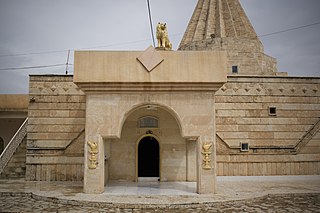
Yazidism, alternatively Sharfadin is a monotheistic ethnic religion that has roots in a western Iranic pre-Zoroastrian religion directly derived from the Indo-Iranian tradition. It is followed by the mainly Kurmanji-speaking Yazidis and is based on belief in one God who created the world and entrusted it into the care of seven Holy Beings, known as Angels. Preeminent among these Angels is Tawûsê Melek, who is the leader of the Angels and who has authority over the world.

‘Adī ibn Musāfir was a Muslim sheikh of Arab origin, considered a Yazidi saint. The Yazidis consider him as an avatar of Tawûsê Melek, which means "Peacock Angel". His tomb at Lalish, Iraq is a focal point of Yazidi pilgrimage.

Lalish is a mountain valley and temple in Shekhan, Duhok Governorate in Iraq. It is the holiest temple of the Yazidis. It is the location of the tomb of the Sheikh Adi ibn Musafir, a central figure of the Yazidi faith.

The Chinvat Bridge or the Bridge of the Requiter in Zoroastrianism is the sifting bridge, which separates the world of the living from the world of the dead. All souls must cross the bridge upon death. The bridge is guarded by two four-eyed dogs, described in the Videvdat (Vendidad) 13,9 as 'spâna pəšu.pâna'.
Sheikh al-Hasan ibn ‘Adī was the son and religious heir of ‘Adī ibn Sakhr and thus head of the Adawiyya order. He was executed in a Mongol purge of the ‘Adawiyyūn in 1254. Şêx Hesen is one of the most important figures in Yazidi religion, rivaling only that of his ancestor, Şêx Adi.

Sheikh Sharaf ad-Dīn ibn al-Hasan was the son and religious heir of al-Hasan ibn ‘Adī and thus head of the ‘Adawiyya order. He died in battle against the Mongols in 1258 and was succeeded by his uncle, Fakhr ad-Dīn ibn ‘Adī. Due to the hostility of the Mongols, his son Zayn ed Din preferred not to become his successor and passed on the duties to Fakhr ad-Dīn ibn ‘Adī, who was married to a Mongol.
Sheikh or Malak Fakhr ad-Dīn is a holy figure venerated in Yazidism, he is considered one of the Seven Divine Beings, to all of whom God assigned the World's affairs, and his earthly incarnation is considered one of the four sons of Ezdina Mir along with Nasirdin, Sheikh Shems, and Sejadin, who are the respective ancestors and patriarchs of the four Şemsanî Sheikh lineages and are considered to have been avatars of the angelic beings. Fexredîn is considered the personification of the Moon, while his brother, Sheikh Shems is the personification of the Sun.
There is a social organizational structure in the Yazidi community. There are three main castes, namely the Mirids, the Sheikhs, and the Pirs. Furthermore, there are positions for dignitaries in the Yazidi hierarchy.
Sheikh Sejadin or Sejad ad-Dīn is one of the Shemsani Sheikhs in Yezidism, along with Sheikh Shems, Fakhraddin, and Nasirdin.

Sheikh Nasirdin, Melek Nasirdin or Naṣir ad-Dīn is a holy figure venerated in Yezidism, he is considered one of the Seven Divine Beings, to all of whom God assigned the World's affairs, and his earthly incarnation is considered one of the four sons of Ezdina Mir along with Sheikh Shems, Fakhraddin, and Sejadin, who are the respective ancestors and patriarchs of the four Şemsanî Sheikh lineages.

Sheikh Shems or Melek Shams ad-Din is a holy figure venerated in Yazidism, he is considered one of the Seven Divine Beings, to all of whom God assigned the World's affairs, and his earthly incarnation is considered one of the four sons of Ezdina Mir along with Nasirdin, Fakhraddin, and Sejadin, who are the respective ancestors and patriarchs of the four Şemsanî Sheikh lineages.
Ezdina Mir or Ezdine Mir is a mythological Yazidi figure who is considered to be the ancestor of the four Shemsani Sheikhs. The four sheikhs are Sheikh Shems, Fakhraddin, Nasirdin, and Sejadin. According to Yazidi oral traditions, Sheikh Adi is said to have met Ezdina Mir when he first went to Lalish.

Sheikh Mand or Sheikh Mend was a 13th-century Yazidi saint. He is the son of Fakhraddin and thus belongs to the Shamseni lineage of sheikhs. His sister was Khatuna Fekhra, revered today as one of the most important Yazidi female saints.

Mam Rashan or Mehmed Reshan was a 12th-century Yazidi saint. The Mam Rashan Shrine on Mount Sinjar was built in honor of him.

Khatuna Fekhra was a 12th-century Yazidi female saint.
Sheikh Obekr or Obekir is a holy figure venerated in Yazidism, he is considered one of the Seven Divine Beings, to all of whom God assigned the World's affairs, and his 13th century earthly incarnation is considered the founding patriarch of the Qatani lineage of Sheikhs.
Shehîd ibn Jerr is the name for Seth in Yazidism.
Sultan Êzîd is a divine figure in the Yazidi religion. Although many scholars consider his name to be derived from that of the second Umayyad caliph Yazid I, many Yazidis consider him to be a separate figure unconnected to the historical Yazid I. Yazidis typically consider him to be part of a triad of divine emanations of God, though he is sometimes also considered to be identical with the angel Melek Tawus, and thus a manifestation or emanation of God.
The Feast of the Assembly is a Yazidi festival.









